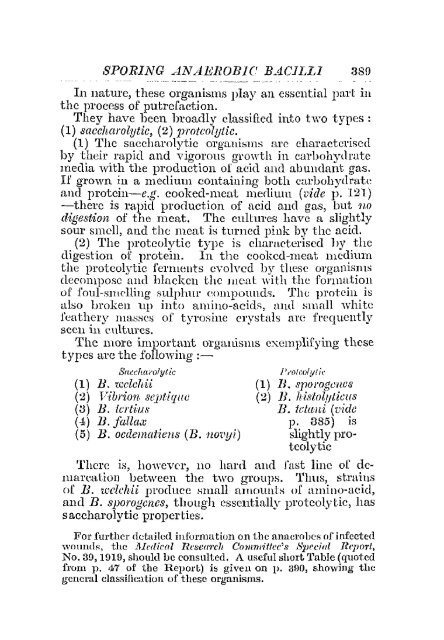AGf~ICULTURAL RESEARCH, PUSA.
AGf~ICULTURAL RESEARCH, PUSA.
AGf~ICULTURAL RESEARCH, PUSA.
You also want an ePaper? Increase the reach of your titles
YUMPU automatically turns print PDFs into web optimized ePapers that Google loves.
SPORING ANAlmOBIC BACILLI 3S0<br />
In nature, these organisms play an essential part ill<br />
the process of putrefaction.<br />
They have been hroadly dassifted into t·wo types:<br />
(1) saccharolytic, (2) proteolytic.<br />
(1) 'l'he saccharolytic orguuisms arc characterised<br />
by their rapid and vigorous growth in carbohytlratc<br />
media with the production of acid and abundant gas.<br />
H grown in a medium containing both carbohydrate<br />
and protein-e.g. cooked-meat meclium (vide p. 121)<br />
-there is rapid production of acid and gas, but no<br />
digestion of the meat. The cultures have a slightly<br />
sour smell, and the meat is turned pink by the acid.<br />
(2) The proteolytic type is characterised hy the<br />
digestion of protein. In the cooked-rncu,t medium<br />
the proteolytic fermeuts evolved by thesc organisms<br />
decompose and blacken the meat with the formation<br />
of foul-smelling sulphur compounds. The protein is<br />
also broken up into amino-acids, and smHll white<br />
feathery masses of tyrosine crystals nrc frequently<br />
seen in cnltures. .<br />
The more important Ol"gauisllls exemplifying these<br />
types are the following :-<br />
S((cchw'olytie<br />
(1) B. wclchii<br />
(2) Fibr'ion septique<br />
(3) B. tertius<br />
(4) B. fallax<br />
(5) B. oedematiens (B. novyi)<br />
I' ,·ot,:o!yl it'<br />
(1) B. s]Jorogciw8<br />
(2) B. histol.llliclis<br />
B. iclani (vide<br />
p. 385) is<br />
slightly proteolytic<br />
Thcre is, ho,vevcr, no hard and J"Ul:>t line of demarcation<br />
between the two groups. 'rhus, strains<br />
of B. wcZchii producc small amounts oj' amino-acid,<br />
and B. spol"ogcnes, though esscntially proteolytic, has<br />
saccharolytic properties.<br />
For further detailed iuformation all the anaerobes of infected<br />
wounds, the AII'dicaZ UrsclI1·ch Co-nmdtfce'8 Special Ill'porl,<br />
No. 39, 1919, should bc consulted. A useful short Table (quot.ed<br />
from p. 47 of the Report) is given on p. 390, showing the<br />
general classiIication of these organisms.

















